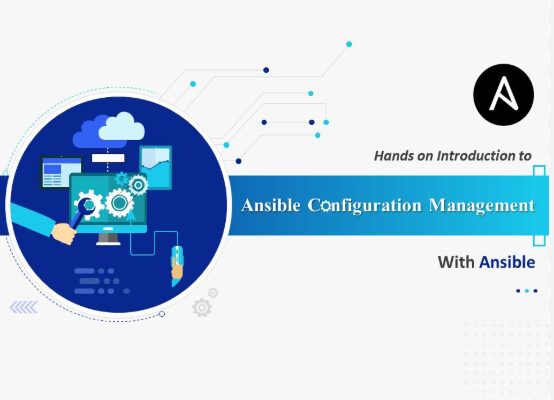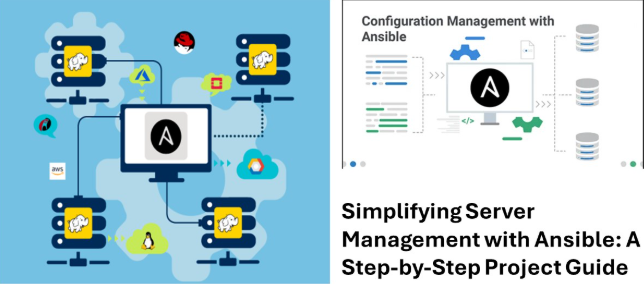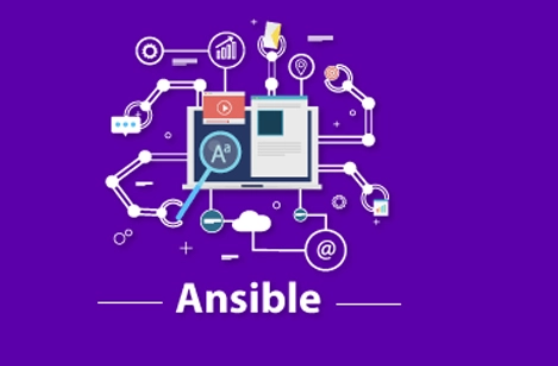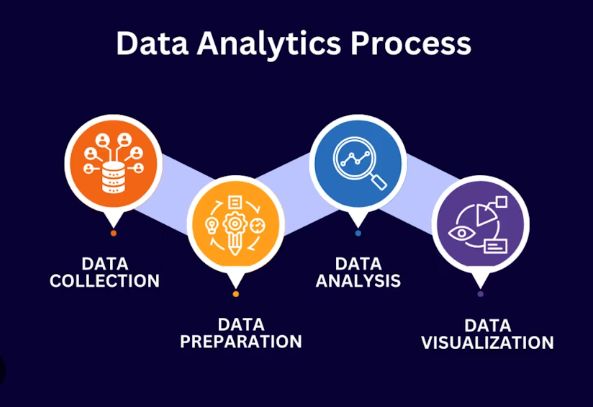
Ansible for configuration management Course in Visakhapatnam | Ansible is an open-source automation engine and a leading tool for configuration management, application deployment, and orchestration. It uses a simple, human-readable YAML syntax for its automation scripts, called playbooks, and offers a powerful, agentless architecture that makes it easy to set up and use.
How Ansible Works for Configuration management
Ansible for configuration management Course in Visakhapatnam | Unlike other tools that require an agent to be installed on managed nodes, Ansible uses a push-based model to execute tasks.
- Control Node: You install Ansible on a central “control node.” This is where you run your automation scripts.
- Inventory: An inventory file lists the servers, network devices, and other targets—the “managed nodes”—that Ansible will configure. Hosts can be organized into groups to apply tasks to specific sets of systems.
- Secure Connection: The control node connects to the managed nodes using standard protocols, primarily SSH for Linux/Unix and WinRM for Windows.
- Modules: Ansible pushes small, self-contained units of code called modules to the managed nodes. These modules perform specific tasks, like installing a package or managing a file.
- Idempotency: Ansible for configuration management Course in Visakhapatnam | Ansible is idempotent, meaning you can run a playbook multiple times with the same outcome. If a system is already in the desired state, Ansible will make no changes, ensuring consistency and preventing errors.
Key components for managing configuration
- Playbooks: Ansible for configuration management Course in Visakhapatnam | These are YAML files that define the configuration tasks you want to automate. Playbooks can declare a desired system state, orchestrate multi-step deployments, and handle complex workflows.
- Modules: With a vast library of built-in modules, Ansible can automate virtually any system administration task. This includes managing packages, services, users, and files.
- Roles: For complex configurations, roles provide a structured way to organize your playbooks and related files (such as templates and variables). Roles make it easy to reuse and share automation code.
- Templates: Ansible uses the Jinja2 templating system to create configuration files dynamically. This allows you to use variables to customize files for different environments (e.g., development, staging, and production). Ansible for configuration management Course in Visakhapatnam|
Example: Installing And Configuring a Web Server

Ansible for configuration management Course in Visakhapatnam | Below is a simple example of an Ansible playbook that installs and starts the Apache web server on a group of servers.
yaml
---
- name: Configure a web server
hosts: webservers
become: yes # Use privilege escalation (e.g., sudo)
tasks:
- name: Install Apache
ansible.builtin.yum: # Or `apt` for Debian-based systems
name: httpd
state: present
- name: Ensure Apache is running and enabled
ansible.builtin.service:
name: httpd
state: started
enabled: yes
- name: Copy a custom index.html file
ansible.builtin.copy:
src: /path/to/your/local/index.html
dest: /var/www/html/index.html
Benefits of using Ansible for configuration management
- Simplified learning curve: Ansible for configuration management Course in Visakhapatnam | The human-readable YAML syntax makes it easy for newcomers to get started quickly.
- Agentless: No agents or special software need to be installed on the managed nodes, which reduces maintenance overhead and simplifies setup.
- Strong community and ecosystem: Ansible has a large, active community that produces extensive documentation and a wide range of pre-built modules and roles.
- Versatility: It can automate tasks across a wide variety of systems, including Linux, Windows, network devices, and cloud services.
- Security and compliance: You can define security policies in playbooks and use Ansible Vault to encrypt sensitive data,Ansible for configuration management Course in Visakhapatnam| ensuring consistent and secure configurations across your infrastructure.
Ansible for configuration management Course in Visakhapatnam | Of course. Here is a comprehensive and structured outline for an Ansible for Configuration Management Course.
Ansible for configuration management Course in Visakhapatnam | This curriculum is designed for systems administrators, DevOps engineers, and developers who want to automate infrastructure provisioning, configuration, and application deployment in an agentless, idempotent manner.
Course Title: Mastering Ansible: Automation for Configuration Management & Deployment

Target Audience: Systems Administrators, DevOps Engineers, Cloud Engineers, and Developers with basic Linux command-line experience.
Prerequisites:
- Proficiency with the Linux command line and SSH.
- Understanding of basic system administration concepts (users, packages, services, files).
- Familiarity with YAML or JSON is helpful but not mandatory.
- No prior programming experience is required, but logical thinking is beneficial.
Course Goal: Ansible for configuration management Course in Visakhapatnam | To equip students with the skills to design, write, and manage Ansible automation to configure systems, deploy software, and orchestrate advanced workflows across on-premises and cloud environments.
Detailed Course Modules
Module 1: The Foundations of Automation & Ansible
- 1.1 The “Why” of Automation: Ansible for configuration management Course in Visakhapatnam | Solving problems of manual configuration drift, scalability, and reproducibility.
- 1.2 Introduction to Configuration Management: Overview of tools (Chef, Puppet, SaltStack) and what makes Ansible unique (agentless, simple YAML language).
- 1.3 How Ansible Works: The core architecture: Control Node vs Managed Nodes, the push-based model, and the role of SSH (WinRM for Windows).
- 1.4 Setting Up Your Lab Environment: Ansible for configuration management Course in Visakhapatnam | Installing Ansible on a control node (Linux/macOS). Configuring SSH key-based authentication for password-less access to managed nodes.
Module 2: Ansible Basics – Playbooks, Inventory, and Ad-Hoc Commands
- 2.1 The Inventory File (
ini/yaml): Ansible for configuration management Course in Visakhapatnam | Defining your hosts. Organizing hosts into groups and using variables within the inventory. - 2.2 Your First Automation: Ad-Hoc Commands: Using the
ansiblecommand-line tool for quick, one-off tasks.- Syntax:
ansible [group] -m [module] -a "[module options]" - Example:
ansible webservers -m ping,ansible all -m apt -a "name=nginx state=present"
- Syntax:
- 2.3 Introduction to Playbooks: The heart of Ansible. Understanding YAML structure. Writing a simple playbook to perform multiple tasks.
- 2.4 Idempotency Demystified: Ansible for configuration management Course in Visakhapatnam | The most important concept. Understanding how Ansible ensures a desired state is achieved, and no change is made if it’s already correct.
Module 3: Mastering the Ansible Module Ecosystem
- 3.1 Module Documentation: How to find and use the official module docs (
ansible-doc). - 3.2 Common System Modules:
- Packages:
apt,yum,dnf,package - Services:
systemd,service - Files:
copy,template,lineinfile,blockinfile - Users & Groups:
user,group - Permissions:
file
- Packages:
- 3.4 Handlers: Triggering actions (like a service restart) only when a change is made by a task. The
notifydirective. - 3.5 Practice Lab: Writing a playbook to fully configure a web server (install nginx, deploy a custom HTML file, ensure the service is running).
Module 4: Organizing with Variables, Facts, and Secrets

- 4.1 Variable Precedence: Ansible for configuration management Course in Visakhapatnam | Understanding where to define variables (inventory, playbooks, files, etc.) and which source wins.
- 4.2 Gathering System Information with Facts: Using the
setupmodule to discover and use auto-discovered variables about managed nodes (ansible_facts). - 4.3 Managing Secrets with Ansible Vault: Encrypting sensitive data (passwords, API keys) into encrypted files and seamlessly using them in playbooks.
- 4.4 Variable Registration: Capturing the output of a command or module with
registerfor use in subsequent tasks.
Module 5: Structuring for Reusability: Roles & Includes
- 5.1 The Problem with Monolithic Playbooks: Why we need to break them up.
- 5.2 Includes and Imports: Using
import_*andinclude_*directives for task and playbook reuse. - 5.3 Ansible Roles – The Ultimate Reusability Tool:
- Understanding the standard role directory structure:
tasks/,handlers/,defaults/,vars/,templates/,files/,meta/. - Creating a role from scratch using
ansible-galaxy init [role_name].
- Understanding the standard role directory structure:
- 5.4 Using Roles from Ansible Galaxy: Finding, evaluating, and using pre-built community roles.
Module 6: Control Flow & Advanced Playbook Techniques
- 6.1 Conditionals (
when): Ansible for configuration management Course in Visakhapatnam | Running tasks only when certain conditions are met (e.g., only on Debian systems, only if a file exists). - 6.2 Loops (
loop,with_*): Iterating over a list of items to perform a task multiple times with different inputs (e.g., creating multiple users, installing multiple packages). - 6.3 Tags (
tags): Applying labels to tasks and plays to allow for running only specific parts of a playbook. - 6.4 Blocks: Grouping tasks together for error handling using
block,rescue, andalways.
Module 7: Targeting Dynamic Environments
- 7.1 Dynamic Inventories: Pulling inventory lists from cloud providers (AWS EC2, Azure VM, GCP Compute) or other dynamic sources (CMDB) using scripts.
- 7.2 Using
delegate_toandlocal_action: Running tasks on a specific host or the control node instead of the target managed node. - 7.3 Working with Environments:
- Managing Differences: Strategies for handling different variables between development, staging, and production environments using group variables.
Module 8: Ansible in the Cloud & for DevOps
- 8.1 Cloud Modules: Introduction to modules for provisioning infrastructure itself (
ec2_instance,azure_rm_virtualmachine,gcp_compute_instance). - 8.2 The Ansible Pull Model: A alternative model for specific use cases where nodes pull their configuration from a git repository.
- 8.3 Integrating with CI/CD Pipelines: How to call Ansible playbooks from Jenkins, GitLab CI, GitHub Actions, etc., for automated deployment pipelines.
- 8.4 Best Practices: Code structure, naming conventions, playbook design, and writing readable, maintainable automation.
Module 9: Capstone Project
- Students are given a scenario to automate the setup of a multi-tier application (e.g., a WordPress site with a web server, database server, and load balancer).
- Requirements:
- Use a dynamic inventory or a well-structured static inventory.
- Create custom roles for each component (e.g.,
nginx,mysql,php,wordpress). - Use variables and secrets appropriately (with Ansible Vault).
- Use handlers for service restarts.
- Include conditional logic and tags.
- The final deliverable is a well-organized Git repository containing all roles, playbooks, inventories, and documentation.
Recommended Tools & Technologies
- Automation Engine: Ansible Core (open-source) / Ansible Automation Platform (enterprise features)
- Control Node: Linux VM (Ubuntu/CentOS) or macOS
- Managed Nodes: Multiple Linux VMs (Ubuntu, CentOS)
- Code Editor: VS Code with Ansible extension (for syntax highlighting and linting)
- Version Control: Git & GitHub/GitLab
- Cloud Provider (Optional): AWS, Azure, or GCP free tier for dynamic inventory labs

Learning Outcomes
Upon completion, students will be able to:
- Articulate the core architecture and benefits of Ansible’s agentless model.
- Write and execute ad-hoc commands for quick management tasks.
- Design, write, and execute idempotent Ansible playbooks using core modules.
- Manage variables, secrets, and system facts effectively.
- Structure complex automation into reusable roles and leverage roles from Ansible Galaxy.
- Implement advanced playbook features like conditionals, loops, and error handling.
- Create dynamic inventories to manage cloud and virtualized environments.
- Integrate Ansible into a CI/CD pipeline for automated deployment.
- Apply best practices to write maintainable, scalable, and secure automation code.
This course is intensely practical, emphasizing hands-on labs and a “learn by doing” approach. The capstone project ensures that students can synthesize all the individual concepts into a coherent, real-world automation solution.



